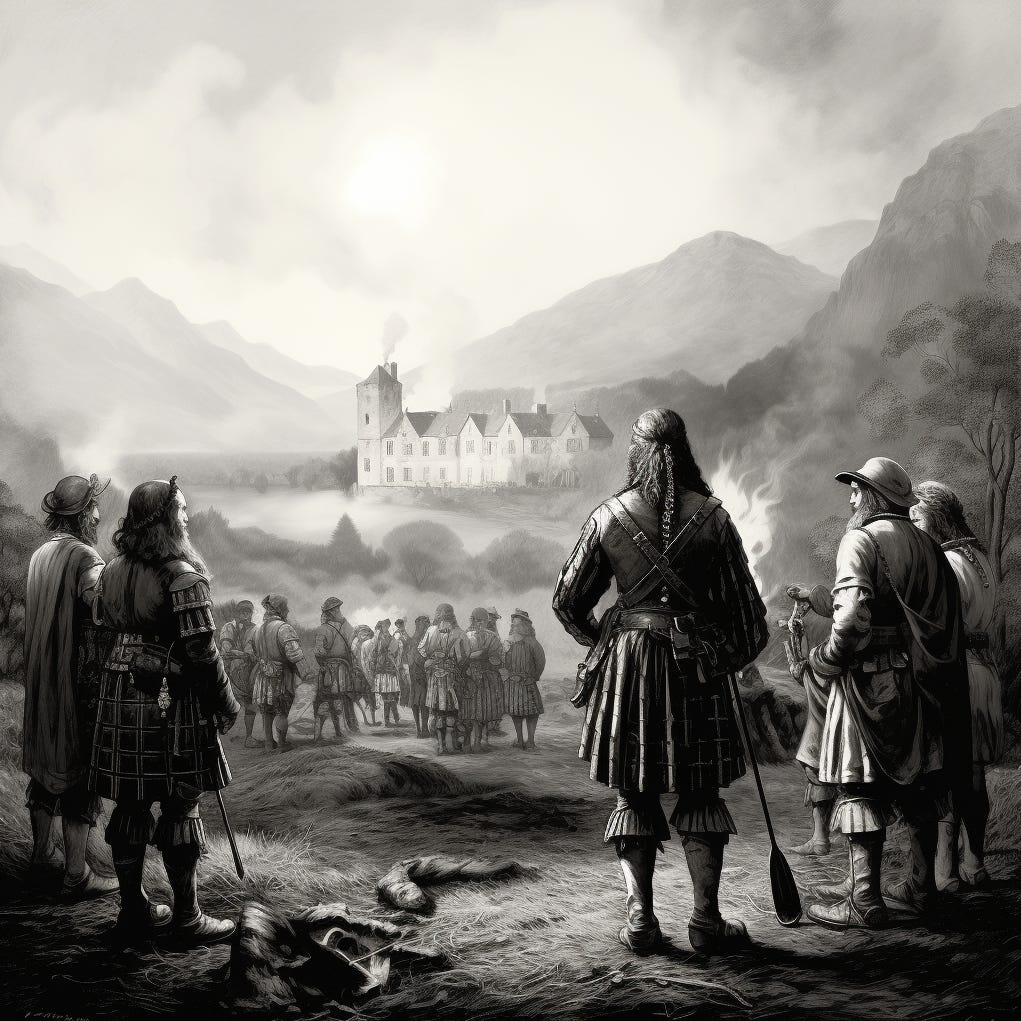The Failed Rebellion of Galbraith and The Clans Exile to Kintyre
Scotland's history is adorned with tales of valiant clans, fierce battles, and dramatic events that have shaped the nation's identity. One such story is the failed rebellion of James Galbraith, a pivotal moment in Clan Galbraith's history. This post delves into the turbulent times of the 15th century, exploring the circumstances that led to the rebellion, the aftermath, and the clan's exile to Kintyre.
Read the new article from our daily premium feed : The Life and Legacy of William Wallace
Clan Galbraith and Their Homeland
To understand the rebellion and exile, it's crucial to comprehend Clan Galbraith's origins and their connection to the Lennox region in Scotland. The Galbraiths, of Gaelic origin, were known as "Breatanuich" or "Children of the Britons." Their stronghold, Inchgalbraith, stood proudly on the western shore of Loch Lomond, in the heart of the Lennox.
The Lennox region, encompassing Loch Lomond and its surroundings, was rich in history and culture. It had been the capital of the Kingdom of Strathclyde, inhabited by native Britons distinct from both the Highland Gaels and Lowland Angles. The Galbraiths, as descendants of the Britons, held a unique place in this tapestry.
Rise of Clan Galbraith
The story of Clan Galbraith takes a significant turn with the rise of Sir William Galbraith of Buthernock, the fourth chief. He married a sister of "Black Comyn," the head of one of the most powerful families in Scotland. Sir William's support for the rescue of the young King Alexander III from Comyn's control solidified his influence. By 1255, he had become one of the co-Regents of Scotland.
Sir William's son, Sir Arthur Galbraith, aligned himself with Robert the Bruce during the Wars of Scottish Independence. His marriage to a sister of Sir James Douglas, known as "Good Sir James," further connected the clan to historical events.
James Galbraith and the Rebellion
The failed rebellion of James Galbraith, the ninth chief, marked a dark chapter in Clan Galbraith's history. In 1425, he joined the rebellion of James Mor Stewart against King James I of Scotland. The rebellion aimed to support the overthrown regent Murdoch Stewart, Duke of Albany.
The consequences of the revolt were severe. As many as 600 clan members were forced into exile, seeking refuge in Kintyre and the Isle of Gigha. They adopted the name MacBhreatneaich, signifying their descent from the Britons.
Causes and Consequences
Several factors contributed to the rebellion's failure and the subsequent exile of Clan Galbraith:
Political Instability: Scotland was rife with political turmoil during this period. The power struggle between different factions often led to shifting allegiances.
Royal Suppression: King James I, determined to quell any opposition, severely punished those involved in the rebellion, leading to exile as a safer alternative.
Clan Rivalries: Clan conflicts and rivalries, such as the one between Clan Galbraith and Clan MacGregor, further complicated the situation.
The consequences of the rebellion were profound. The Galbraiths, now MacBhreatneaich, faced a new identity and life in exile, far from their ancestral lands in Lennox.
The Clan in Exile
The clan's exile to Kintyre and the Isle of Gigha marked a period of adaptation and survival. As MacBhreatneaich, they embraced a new identity while preserving their heritage.
New Name, New Identity: The adoption of the name MacBhreatneaich reflected their descent from the Britons and allowed them to integrate into their new communities.
Struggles and Challenges: Exile brought numerous challenges, including economic hardships and the need to rebuild their lives in a new environment.
Cultural Preservation: Despite the challenges, the clan managed to preserve its unique culture, traditions, and oral history.
Legacy and Rediscovery
The failed rebellion and exile to Kintyre remained a significant chapter in Clan Galbraith's history. Over time, the clan's legacy persisted, and their story was rediscovered by historians and descendants.
Revival of Interest: In recent years, there has been a resurgence of interest in Clan Galbraith's history, driven by descendants eager to reconnect with their heritage.
Recognition and Reconnection: The clan's history is now celebrated through heritage associations and gatherings, allowing modern Galbraiths to reconnect with their roots.
Preserving the Story: Efforts are being made to document and preserve the clan's history, ensuring that the tale of James Galbraith and the exile to Kintyre is never forgotten.
Conclusion
The failed rebellion of James Galbraith and the subsequent exile to Kintyre is a compelling chapter in Scottish clan history. It underscores the complexities of medieval Scotland, where shifting loyalties, political instability, and clan rivalries could alter the course of a family's destiny. Despite the challenges faced by Clan Galbraith, their legacy endures, a testament to the resilience of a proud and ancient clan.





